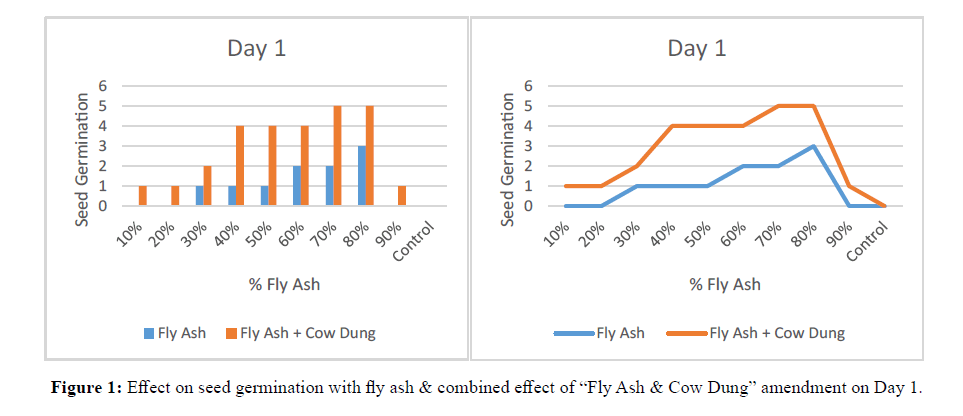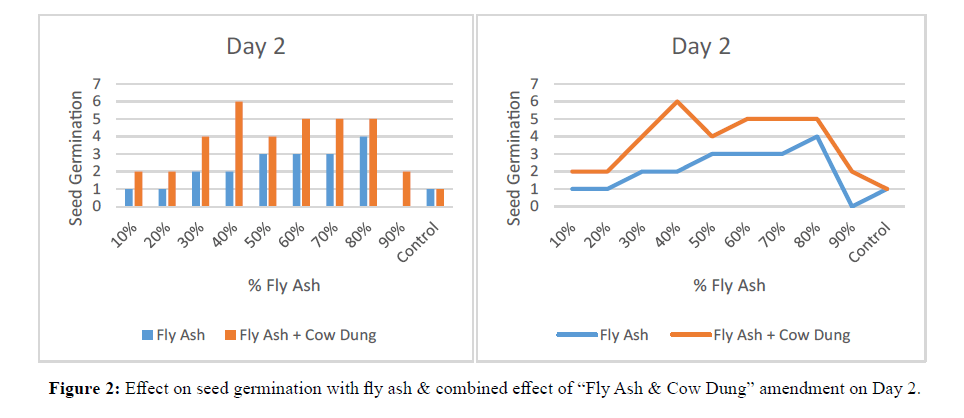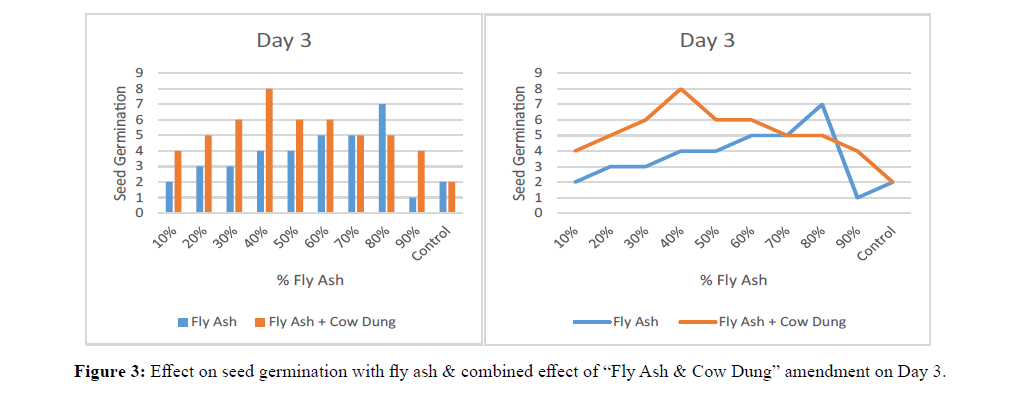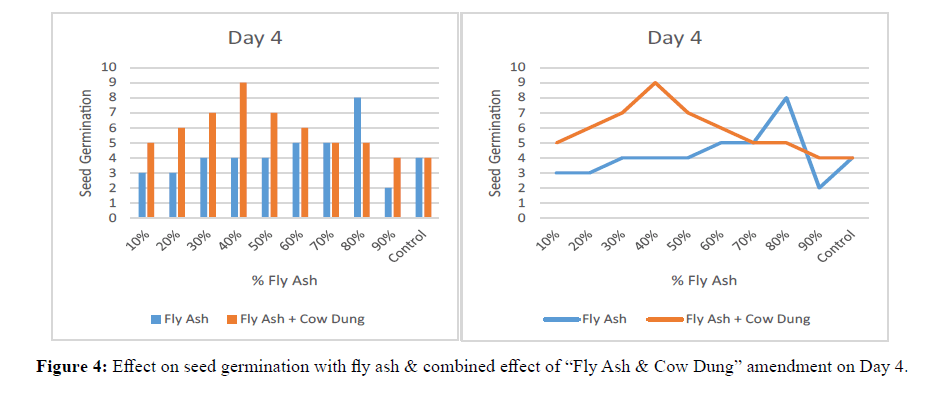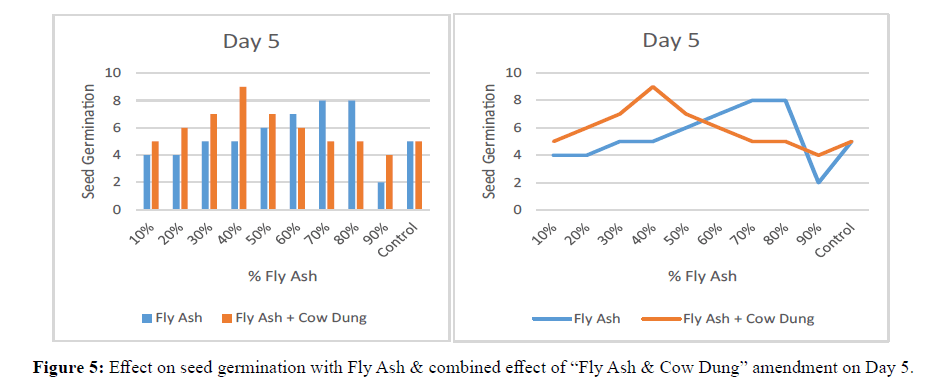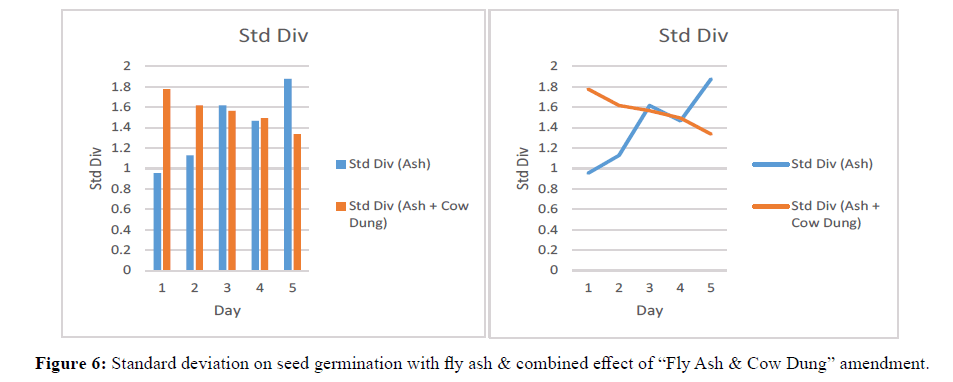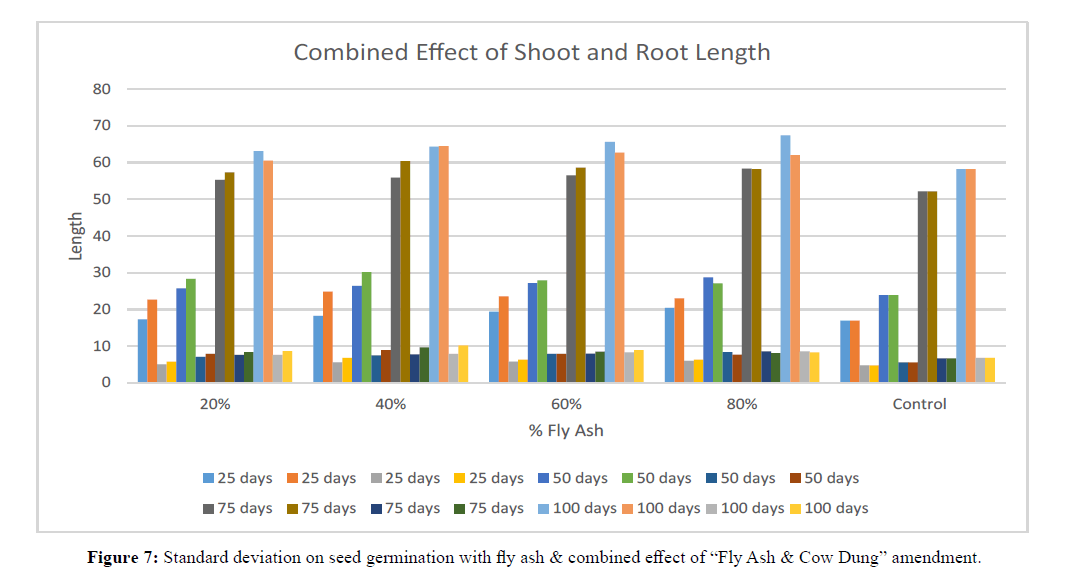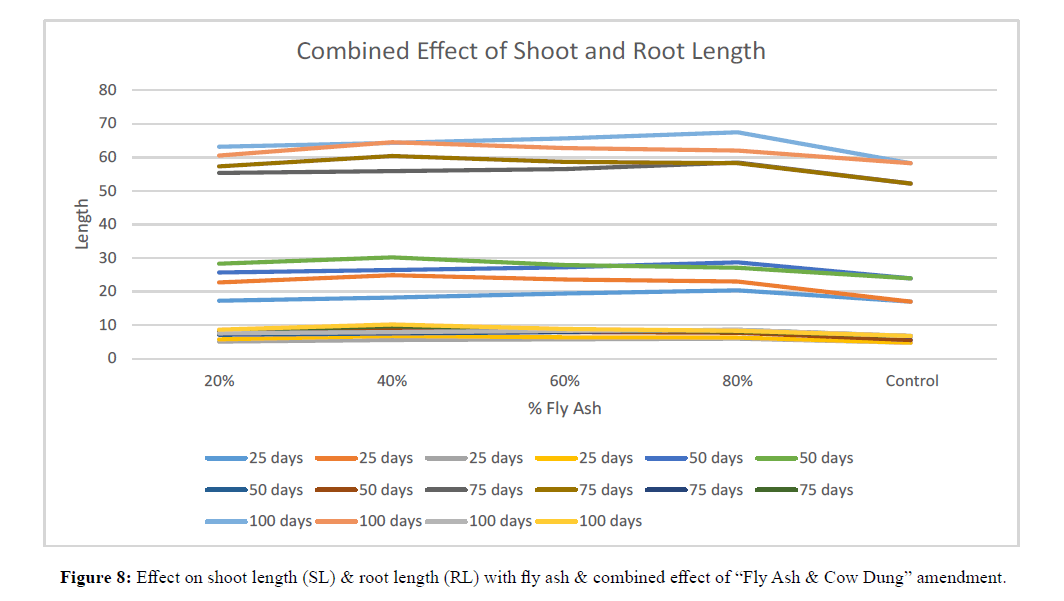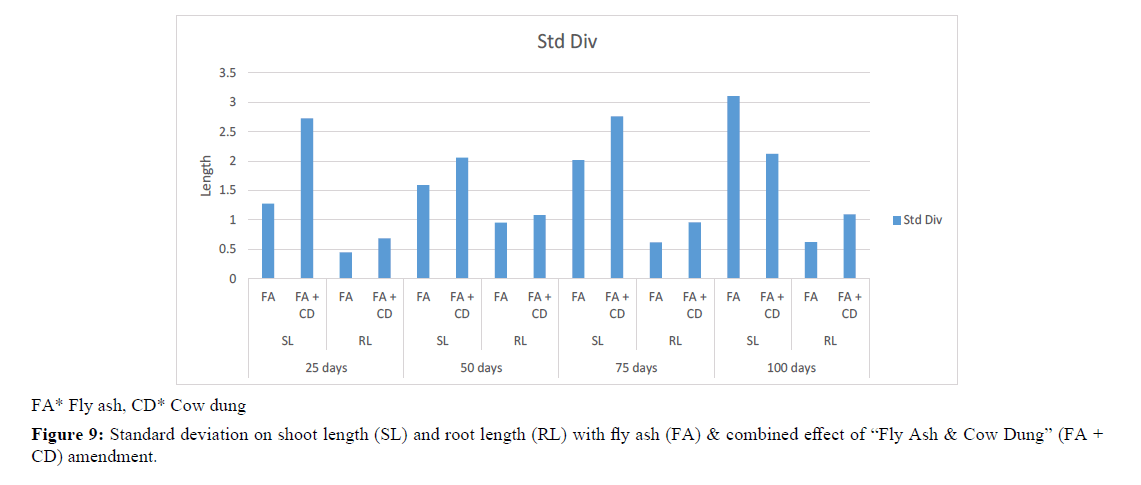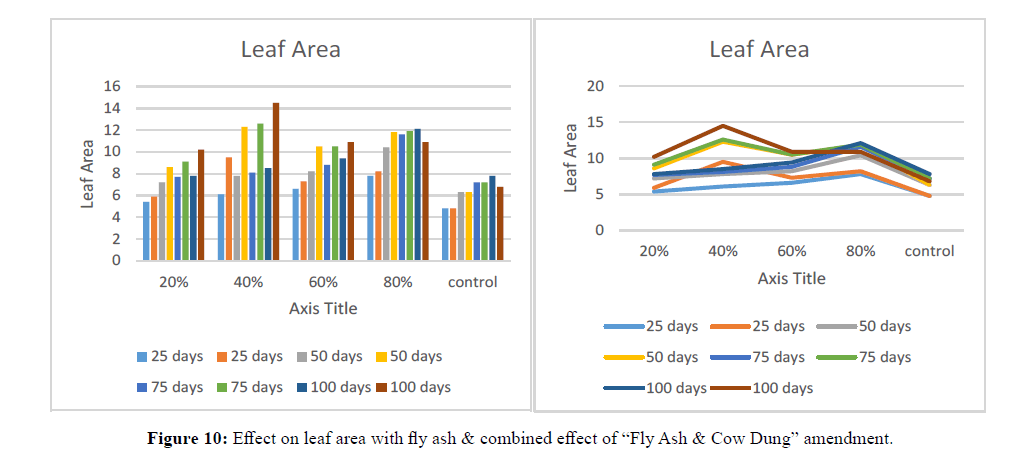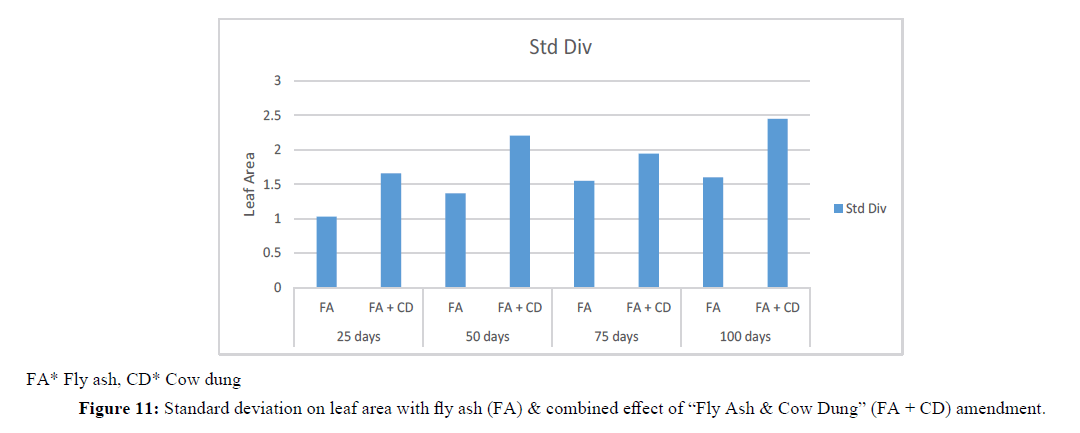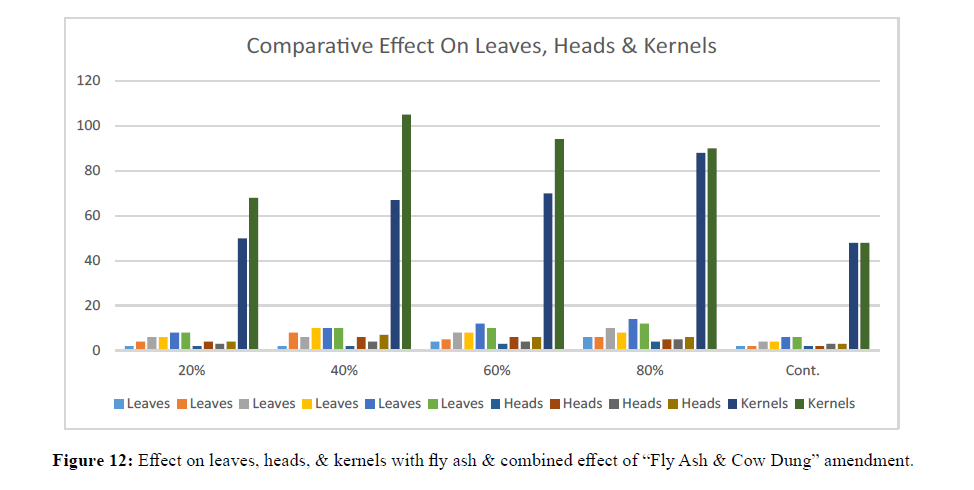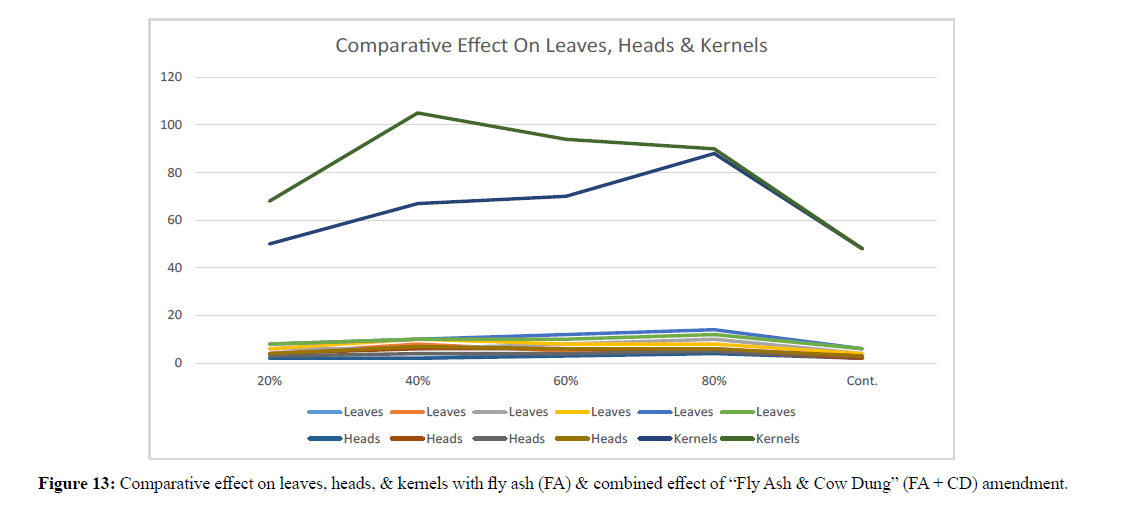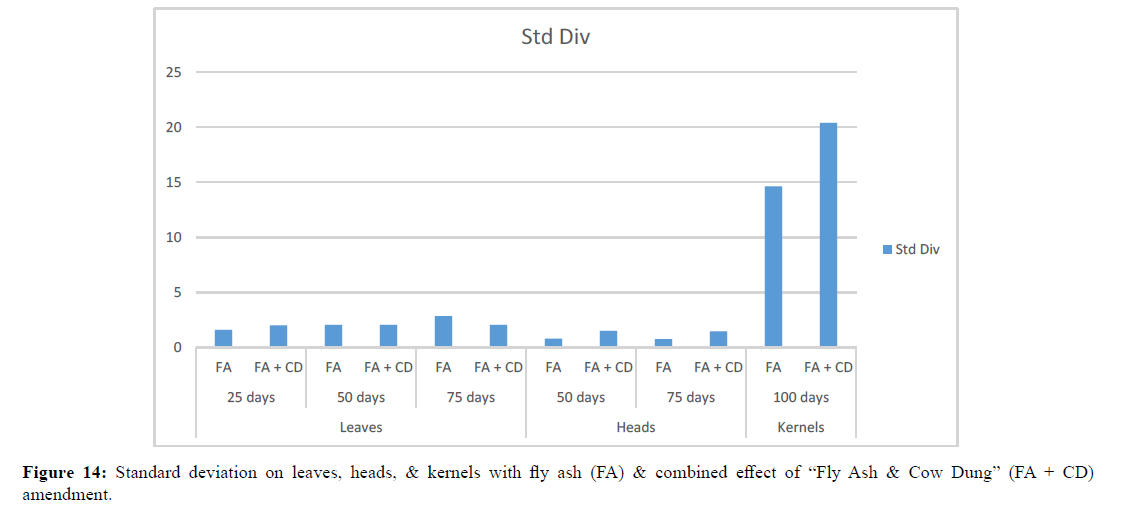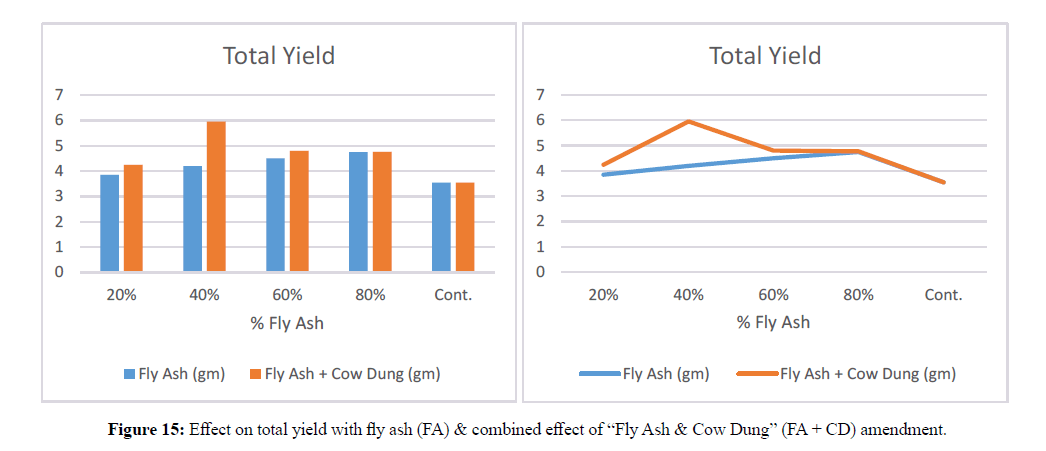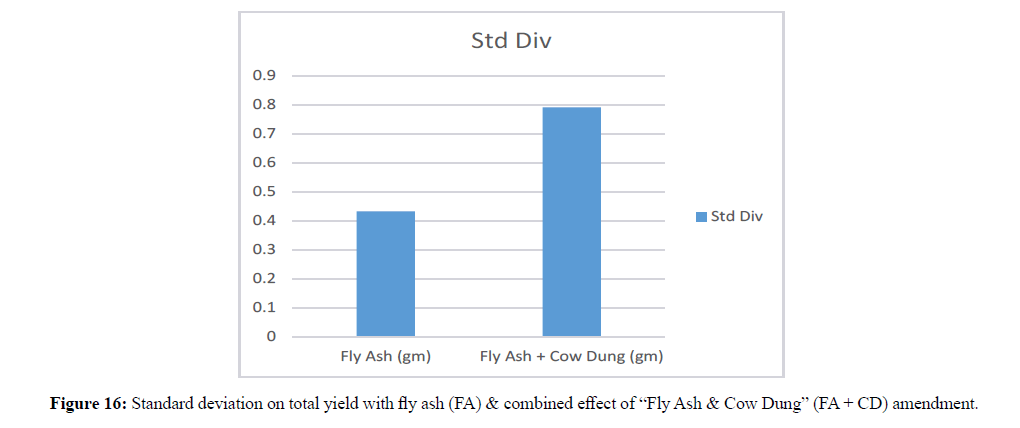ISSN : 2249 - 7412
Asian Journal of Plant Science & Research
Study of Combine Effect with Fly Ash and Cow Dung Amendment on Morphological Status of Indian Wheat Plant (Triticum aestivum L.)
Meenakshi Sharma*, Rashmi Varma
Department of Botany, Government Kolasib College, Mizoram, India
Abstract
The work is based on the prospects utilization of fly ash with cow dung in agriculture field for the betterment of crop production without any use of harmful chemical fertilizers. Fly ash is a byproduct of coal burning in the thermal power plants. Fly ash is a rich source of macro and micro supplements. It also contains some toxic metals. The effect of these toxic metals can be overcome by the combined amendment of Fly ash and cow dung in agriculture sector to improve crop production.
Keywords
Fly ash; Cow dung; Morphological status; Macro and micro supplements
Introduction
Around 82 thermal power plants operating in the country and generate nearby 85 million tons of fly ash as a waste matter, per annum and it is expected that it will reach up to 40 million tons during the year 2020 [1]. Fly ash is a prospective source of many macro and micro supplements including some toxic metals [2]. It contains almost all the essential plant supplements. Nature and composition of Fly ash depends on the type of coal, used for combustion in Thermal power plants. It has similar physicochemical properties like soil. So, Fly ash has great efficiency as a nutrient supplement. Fly ash is really a good source of trace elements that are readily available to the crop when mixed with soil.
The study of Fly ash amendment for better yield has been done on Helianthus annus, Beta vulgaris, Triticum aestivum L., Esculenta moench, oryza sativa L., and zea mays [3,4]. Use of Fly ash as an amendment in agriculture up to 60% for the wheat (Triticum aestivum), 10 to 20 % for mung beans (vigna radiate), and beans (Vigna munga ) was found to be suitable for maximum growth and yield as observed by [5].
Swamy et al. studied increasing trend of all the growth parameters such as root length, shoot length, root numbers with fly ash amendment using Allium cepa species [6]. Crop plants of the families Brassicaceae, Chenopodiaceae, Fabaceae and poaceae are most tolerant to Fly ash [7]. Fly ash can be good additive for neutralizing the acidic soil and will also help as organic fertilizer and it also helpful for seed germination .Fly ash is a good supplement for agriculture field but due to presence of some toxic heavy elements the use of Fly ash has limitations. These limitations can be suppressed by the additional use of cow dung with Fly ash.
The proposed work deals with the combined effect of Fly ash and Cow dung on the morphological parameters of Indian wheat crop.
Materials and Methods
Collection of Materials
- The Fly ash was collected from Kota thermal power plant, Rajasthan, India.
- The soil was collected from “Sajag ji ka park” police line, Gopal vihar, Kota Raj, India.
- Cow dung was collect from milk form house Aditya a was Kota Raj.
- Certified seeds were purchased from seed department Bajarang nagar Kota Raj.
- Cemented pots were purchased from road side near Borkheda Kota.
The Fly ash, Cow dung and Soil were open sun dried for a period of seven days during the month of June ,than crush to make powder and sieved (2 mm size).
Experiment Set Up
Wheat is Rabi crop, so pot experiment was conducted during the winter season 2019. Two sets of pot experiment were prepared. One with soil amended by Fly ash and another with combined amendment of Fly ash and cow dung.
Experiment (1): Pots were prepared with Fly ash amendment according to the ratio of 10%, 20%, 30%, 40%, 50%, 60%, 70%, 80%, 90% with control (100% soil)
Experiment (2): Pots were prepared with combined amendment of Fly ash and cow dung along with control, according to above mentioned ratio. Along with control, we also maintain a pot with 100% Fly ash and another with 100% cow dung to study the individual effect.
Before sowing, seeds were sterilized with 0.1% mercuric chloride than washed with distilled water and soaked overnight before sowing, seeds were sown in each pot with depth of 1 cm, 15 seeds in each pot were disperse. The pots were watered with normal tap water with the interval of two days. The plants in each pot were carefully monitored.
Physicochemical Analysis of Fly Ash and Soil
Physic-chemical analysis done with the respect of following factor, these are soil texture, soil pH, soil texture, porosity, water holding capacity has done by basic method (Table 1).
| Parameters | Fly ash | Soilz |
|---|---|---|
| pH | 8.42 | 7.36 |
| E.C.(ds/m) | 0.47 | 0.42 |
| Organic carbon | 0.42 | 1.11 |
| N (Kg/ha ) | 32.44 | 160.2 |
| P (kg/ha) | 38.3 | 25.2 |
| K (Kg/ha) | 735.0 | 387.1 |
| Fe(g/kg) | 12.2×10-3 | 9.3 |
| Cu(g/kg) | 0.379×10-3 | 2.85 |
| Zn(g/Kg) | 0.72×10-3 | 1.55 |
Table 1: Analysis of micronutrients (Cu, Fe and Zn done by DTPA test).
Analysis of macro nutrient has done by following method,
- Analysis of nitrogen-Kzeldahl method.
- Analysis of phosphorus-Olsen et al. method.
- Analysis of potassium-Flame photometer.
Observation and Results
Observation of Seed Germination
Percentage of seed germination was determined by Roll Towel method. For this 10 seeds were taken for each application. Seeds were water soaked before the germination test. Filtered solution of each ratio of Fly ash and cow dung was prepared for to do spray on the seeds, on each set of roll towel .For seed germination test. Observation has done regularly up to five days.
Observation revealed that maximum seed germination occurs with 80% Fly ash. 8 seeds were germinated out of 10 seeds .The result shown that 80% seeds germinated with 80% Fly ash amendment (Table 2).
| Fly ash amended seeds (seed germination) |
Fly ash with cow dung amended seeds (seed germination ) |
||||||||||
|---|---|---|---|---|---|---|---|---|---|---|---|
| Day-- | 1 | 2 | 3 | 4 | 5 | 1 | 2 | 3 | 4 | 5 | |
| 10% | 0 | 1 | 2 | 3 | 4 | 1 | 2 | 4 | 5 | 5 | |
| 20% | 0 | 1 | 3 | 3 | 4 | 1 | 2 | 5 | 6 | 6 | |
| 30% | 1 | 2 | 3 | 4 | 5 | 2 | 4 | 6 | 7 | 7 | |
| 40% | 1 | 2 | 4 | 4 | 5 | 4 | 6 | 8 | 9 | 9 | |
| 50% | 1 | 3 | 4 | 4 | 6 | 4 | 4 | 6 | 7 | 7 | |
| 60% | 2 | 3 | 5 | 5 | 7 | 4 | 5 | 6 | 6 | 6 | |
| 70% | 2 | 3 | 5 | 5 | 7 | 5 | 5 | 5 | 5 | 5 | |
| 80% | 3 | 4 | 7 | 8 | 8 | 5 | 5 | 5 | 5 | 5 | |
| 90% | 0 | 0 | 1 | 2 | 2 | 1 | 2 | 4 | 4 | 4 | |
| Control | 0 | 1 | 2 | 4 | 5 | 0 | 1 | 2 | 4 | 5 | |
Table 2: Results of seed germination with Fly ash and cow dung.
The results of combined amendment have shown that maximum seed germination (90%) of Wheat occurs with 40% amendment of Fly ash with cow dung. The amendment of cow dung with Fly ash induces early seed germination (Figures 1-6).
The results shown that Fly ash amendment showed maximum seed germination of Indian wheat (Tritium aestivum) with 80% ratio and combined amendment of Fly ash and cow dung shown maximum seed germination with 40% ratio.
Shoot and Root Length Observation
The study on the effect of fly ash amendment on root and shoot length on Wheat revealed that both the length of root and shoot were maximum with 80% amendment of the Fly ash .While the combined amendment of Fly ash and cow dung shown maximum length of root and shoot with 40% ratio. The length of root and shoot gradually decreased with further amendment (Table 3) (Figures 7-11).
| Fly ash amendment | Fly Ash amended with cow dung | |||||||||||||||
|---|---|---|---|---|---|---|---|---|---|---|---|---|---|---|---|---|
| Day | 25 days | 50days | 75days | 100days | 25days | 50days | 75days | 100 days | ||||||||
| L | SL | RL | SL | RL | SL | RL | SL | RL | SL | RL | SL | RL | SL | RL | SL | RL |
| 20% | 17.3 | 5.1 | 25.7 | 7.1 | 55.3 | 7.6 | 63.1 | 7.6 | 22.7 | 5.8 | 28.3 | 7.9 | 57.3 | 8.4 | 60.5 | 8.7 |
| 40% | 18.2 | 5.6 | 26.4 | 7.5 | 55.9 | 7.8 | 64.3 | 7.9 | 24.9 | 6.8 | 30.2 | 8.9 | 60.4 | 9.7 | 64.5 | 10.2 |
| 60% | 19.4 | 5.8 | 27.2 | 7.9 | 56.5 | 8.0 | 65.6 | 8.3 | 23.6 | 6.4 | 27.9 | 7.9 | 58.6 | 8.5 | 62.7 | 8.9 |
| 80% | 20.4 | 6.0 | 28.7 | 8.4 | 58.4 | 8.6 | 67.4 | 8.6 | 23.0 | 6.3 | 27.1 | 7.7 | 58.2 | 8.1 | 62.0 | 8.3 |
| C | 17.0 | 4.8 | 23.9 | 5.6 | 52.2 | 6.7 | 58.2 | 6.8 | 17.0 | 4.8 | 23.9 | 5.6 | 52.2 | 6.7 | 58.2 | 6.8 |
*RL= Root Length, SL=Shoot Length
Table 3: Observations of shoot length and root length with fly ash and cow dung.
Observation of Leaf Area Index- L A I = {leaf area (m2)/ground cover (m2)}
Leaf area of Wheat leaf was calculated by Quarrie and Jones equation [8]. Leaf area = Length x Breadth x 0.75
Results of leaf area revealed that during the Fly ash amendment 80% ratio of the Fly ash shown maximum leaf area where as combined amendment of Fly Ash with cow dung shown maximum leaf area with the ratio of 40%, further more amendment gradually decrease the Leaf area.
Observation of Number of Leaves, Heads and Kernels
Results of both observation has shown that the no of leaves gradually increase up to 80% amendment of Fly ash, but in case of combined amendment the no. of leaves increase up to 40% amendment of Fly ash with cow dung. Whereas the no. of Heads and Kernels were also maximum with 80% amendment of Fly ash and with combined amendment it shown maximum results with 40% amendment (Table 4) (Figures 12-14).
Observation of Total Yield with Per Plant
Effect of Fly ash was observed with respect of per plant yield. The results revealed that the per plant yield increase gradually from control to 80 % amendment of Fly ash (yield were cont=3.85 gm for20% FA, 4.20 gm for 40% FA , 4.50 gm for 60% FA, 4.75 gm for 80% FA) but during the combined amendment of Fly ash with cow dung the yield of per Wheat plant was significantly increase from control to 40% amendment (20%=4.24 gm, 40%=5.96 gm, 60%=4.80, 80% 4.77 gm). The results of comparative analysis also revealed that each combined amendment shown better results than each amendment of Fly ash (Table 5) (Figures 15 and 16).
Discussion
The results of physic-chemical analysis of soil and Fly ash revealed that the pH value of Fly ash is 8.42 whereas the pH value of soil is 7.36. Higher pH value of Fly ash revealed the alkaline nature of Fly ash. Fly ash amendment increases the soil pH. This was due to acid neutralizing properties of Fly ash as reported by Gupta et al. [9]. Fly Ash amendment was responsible to enhance soil pH values which could be possible due to high content of CaO and MgO. The morphological parameter of Indian Wheat (Triticum aestivum) such as length of shoot, length of root, seed germination, leaf area, total yield of per plant reveal maximum results with 80 % amendment of Fly ash. Further increase in Fly ash shown decrease resultant in the morphological parameters. This observation follow the findings of Niaz et al. [10].The results of combined amendment of Fly ash with cow dung shown maximum results with 40% amendment and the number of leaves were found maximum with 60% amendment, which reveal that cow dung provide organic matter for plant growth as reported by Lekasi et al. [11].
Applications of Fly ash up to 80% were found to be effective and beneficial for the Wheat growth in the present study. Present study revealed that available nutrients present in fly ash were beneficial for the Wheat (Triticum aestivum) with or without cow dung up to certain levels. Due to nutritional value of Fly ash it can be used as a safe and eco-friendly fertilizer. Amendment of Cow dung with Fly ash supports it for better production.
Conclusion
The Fly ashes contains all the essential plant nutrients and play an important role to improve soil health and its productivity without causing any harmful effect. Due to its nutritional value Fly ash could be used in agricultural sector to improve soil fertility and its productivity in form of organic and eco-friendly cultivation The present study exposes significant increase in yield as well as morphological nature and biomass without any adverse effect on soil and crop health. The present study also play a significant role to minimize the disposal problem of huge amount of Fly ash in a healthy and safe set way.
References
- Tripathi RD, Kulshreshtha K, Singh SN, Rai UN, Singh N, et al. Performance of Brassica campastris for utilization of solid waste of coal combustion residue (Fly ash). Second international conference on plants and Environment pollution (ICPEP-2), NBRI, Lucknow. 2002.
- Mehra A, Farago ME, Banerjee DK. Impact of Fly Ash from coal fired power station in Delhi, with particular reference to metal contamination. Environ Monitor Assess. 1986, 50:15-35.
- Pandey V, Mishra S, Singh, SN, Singh N, Yunus M, et al. Growth response of Helianthus Annus L., grown on Fly Ash amended soil. Environ Biol. 1994, 15:117-125.
- Kalra N, Choudhary A, Sharma SK, Vatsa BK, Kumar V, et al. Impact of Fly Ash on agriculture. ICAR News. 1997, 3:20.
- Mahale NK, Patil SD, Sarode DB, Attarde SB. Effect of Fly ash as an add mixture in agriculture and study of heavy metal accumulation in Wheat, Mung bean and Urad bean. Pol J Environ Stud. 2012, 21(6):1713-1719.
- Swamy TN, Dash N, Nahak G, Deo B, Sahu RK. Effect of coal fly ash on growth, biochemistry, cytology and heavy metal content of Aliulm cepa L. NY Sci J. 2010, 3(5):10-16.
- Cheung KC, Wong JPK, Zhang ZQ, Wong JWC, Wong Mh. Revegetation of lagoon ash using the Legume species Acacia auriculiformis and Leucaena leuocephala. Environ Pollut. 2006, 109:75-82.
- Aldesuquy H, Baka Z, Mikky. Kinetin and supermine mediated induction of salt tolerance in Wheat plant: Leaf area, photosynthesis and chloroplast ultrastructure of flag leaf at ear emergence. Egypt J Basic Appl Sci. 2014.
- Gupta AK, Dwivedi S, Sinha S, Tripathy RD, Rai UN, et al. Metal accumulation and growth performance of phaseolus vulgaris grown in Fly Ash amended soil. Bioresour Technol. 2007, 98:3404-3407.
- Niaz T, Hisamuddin A, Roabab MI. Impact of Fly Ash amended soil on growth, quality and productivity of Elipta. Trends Biosci. 2008, 12:46-48.
- Lekasi JK, Ndung’u KW, Kifuko MN. Organic resource management in Kenya. Perspective and Guidelines. Forum for Organic Resource Management and Agricultural Technologies (FORMAT). Kenya. 2005.

Open Access Journals
- Aquaculture & Veterinary Science
- Chemistry & Chemical Sciences
- Clinical Sciences
- Engineering
- General Science
- Genetics & Molecular Biology
- Health Care & Nursing
- Immunology & Microbiology
- Materials Science
- Mathematics & Physics
- Medical Sciences
- Neurology & Psychiatry
- Oncology & Cancer Science
- Pharmaceutical Sciences
